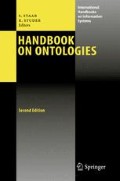Summary
We overview the algorithms for reasoning with description logic (DL) ontologies based on resolution. These algorithms often have worst-case optimal complexity, and, by relying on vast experience in building resolution theorem provers, they can be implemented efficiently. Furthermore, we present a resolution-based algorithm that reduces a DL knowledge base into a disjunctive datalog program, while preserving the set of entailed facts. This reduction enables the application of optimization techniques from deductive databases, such as magic sets, to reasoning in DLs. This approach has proven itself in practice on ontologies with relatively small and simple TBoxes, but large ABoxes.
Access this chapter
Tax calculation will be finalised at checkout
Purchases are for personal use only
Notes
References
S. Abiteboul, R. Hull, and V. Vianu. Foundations of Databases. Addison Wesley, 1995.
F. Baader, D. Calvanese, D. McGuinness, D. Nardi, and P. F. Patel-Schneider, editors. The Description Logic Handbook: Theory, Implementation and Applications. Cambridge University Press, January 2003.
F. Baader and W. Snyder. Unification Theory. In A. Robinson and A. Voronkov, editors, Handbook of Automated Reasoning, volume I, chapter 8, pages 445–532. 2001.
L. Bachmair and H. Ganzinger. Resolution Theorem Proving. In A. Robinson and A. Voronkov, editors, Handbook of Automated Reasoning, volume I, chapter 2, pages 19–99. 2001.
L. Bachmair, H. Ganzinger, C. Lynch, and W. Snyder. Basic Paramodulation. Information and Computation, 121(2):172–192, 1995.
C. Beeri and R. Ramakrishnan. On the power of magic. In Proc. PODS ’87, pages 269–283, San Diego, CA, USA, 1987.
A. Borgida. On the Relative Expressiveness of Description Logics and Predicate Logics. Artificial Intelligence, 82(1–2):353–367, 1996.
M. Buchheit, F. M. Donini, and A. Schaerf. Decidable Reasoning in Terminological Knowledge Representation Systems. Journal of Artificial Intelligence Research, 1:109–138, 1993.
M. Davis, G. Logemann, and D. Loveland. A Machine Program for Theorem-Proving. Communications of the ACM, 5(7):394–397, 1962.
N. Dershowitz and D. A. Plaisted. Rewriting. In A. Robinson and A. Voronkov, editors, Handbook of Automated Reasoning, volume I, chapter 9, pages 535–610. 2001.
T. Eiter, G. Gottlob, and H. Mannila. Disjunctive Datalog. ACM Transactions on Database Systems, 22(3):364–418, 1997.
I. Horrocks and U. Sattler. A Description Logic with Transitive and Inverse Roles and Role Hierarchies. Journal of Logic and Computation, 9(3):385–410, 1999.
U. Hustadt, B. Motik, and U. Sattler. Reducing \({\mathcal{S}\mathcal{H}\mathcal{I}\mathcal{Q}}^{-}\) Description Logic to Disjunctive Datalog Programs. In Proc. KR 2004, pages 152–162, Whistler, Canada, 2004.
U. Hustadt, B. Motik, and U. Sattler. A Decomposition Rule for Decision Procedures by Resolution-based Calculi. In Proc. LPAR 2004, pages 21–35, Uruguay, 2005.
U. Hustadt, B. Motik, and U. Sattler. Data Complexity of Reasoning in Very Expressive Description Logics. In Proc. IJCAI 2005, pages 466–471, Edinburgh, UK, 2005.
U. Hustadt and R. A. Schmidt. On the Relation of Resolution and Tableaux Proof Systems for Description Logics. In Proc. IJCAI ’99, pages 202–207, Stockhom, Sweden, 1999.
W. H. Joyner. Resolution Strategies as Decision Procedures. Journal of the ACM, 23(3):398–417, 1976.
Y. Kazakov and H. de Nivelle. A Resolution Decision Procedure for the Guarded Fragment with Transitive Guards. In Proc. IJCAR 2004, pages 122–136, Cork, Ireland, 2004.
Y. Kazakov and B. Motik. A Resolution-Based Decision Procedure for \(\mathcal{S}\mathcal{H}\mathcal{O}\mathcal{I}\mathcal{Q}\). In Proc. IJCAR 2006, pages 662–667, Seattle, WA, USA, 2006.
O. Kutz, I. Horrocks, and U. Sattler. The Even More Irresistible SROIQ. In Proc. KR 2006, pages 68–78, Lake District, UK, 2006.
C. Lutz and U. Sattler. The Complexity of Reasoning with Boolean Modal Logics. In Proc. AiML 2000, pages 329–348, Leipzig, Germany, 2001.
B. Motik. Reasoning in Description Logics using Resolution and Deductive Databases. PhD thesis, Univesität Karlsruhe (TH), Karlsruhe, Germany, January 2006.
B. Motik and U. Sattler. A Comparison of Reasoning Techniques for Querying Large Description Logic ABoxes. In Proc. LPAR 2006, pages 227–241, Cambodia, 2006.
R. Nieuwenhuis and A. Rubio. Theorem Proving with Ordering and Equality Constrained Clauses. Journal of Symbolic Computation, 19(4):312–351, 1995.
H. De Nivelle, R. A. Schmidt, and U. Hustadt. Resolution-Based Methods for Modal Logics. Logic Journal of the IGPL, 8(3):265–292, 2000.
A. Nonnengart and C. Weidenbach. Computing Small Clause Normal Forms. In A. Robinson and A. Voronkov, editors, Handbook of Automated Reasoning, volume I, chapter 6, pages 335–367. 2001.
D. A. Plaisted and S. Greenbaum. A Structure-Preserving Clause Form Translation. Journal of Symbolic Logic and Computation, 2(3):293–304, 1986.
A. Riazanov and A. Voronkov. The design and implementation of VAMPIRE. AI Communications, 15(2–3):91–110, 2002.
R. A. Schmidt and U. Hustadt. A Principle for Incorporating Axioms into the First-Order Translation of Modal Formulae. In Proc. CADE-19, pages 412–426, USA, 2003.
S. Tobies. Complexity Results and Practical Algorithms for Logics in Knowledge Representation. PhD thesis, RWTH Aachen, Germany, 2001.
M. Vardi. The Complexity of Relational Query Languages. In Proc. STOC ’82, pages 137–146, San Francisco, CA, USA, 1982.
Author information
Authors and Affiliations
Corresponding author
Editor information
Editors and Affiliations
Rights and permissions
Copyright information
© 2009 Springer-Verlag Berlin Heidelberg
About this chapter
Cite this chapter
Motik, B. (2009). Resolution-Based Reasoning for Ontologies. In: Staab, S., Studer, R. (eds) Handbook on Ontologies. International Handbooks on Information Systems. Springer, Berlin, Heidelberg. https://doi.org/10.1007/978-3-540-92673-3_24
Download citation
DOI: https://doi.org/10.1007/978-3-540-92673-3_24
Published:
Publisher Name: Springer, Berlin, Heidelberg
Print ISBN: 978-3-540-70999-2
Online ISBN: 978-3-540-92673-3
eBook Packages: Computer ScienceComputer Science (R0)

